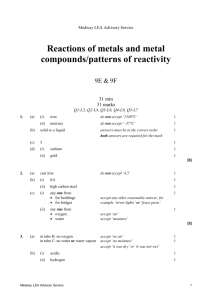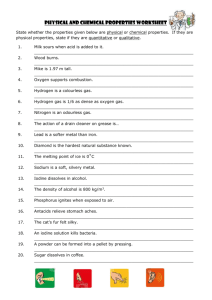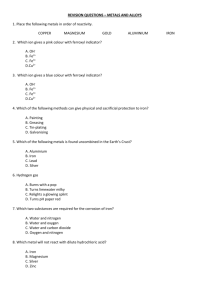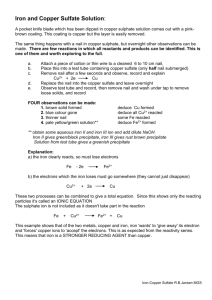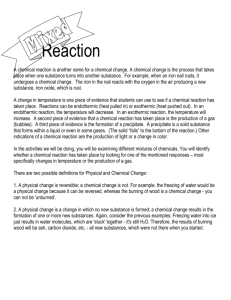Reactions of metals and metal compounds/patterns of reactivity
advertisement
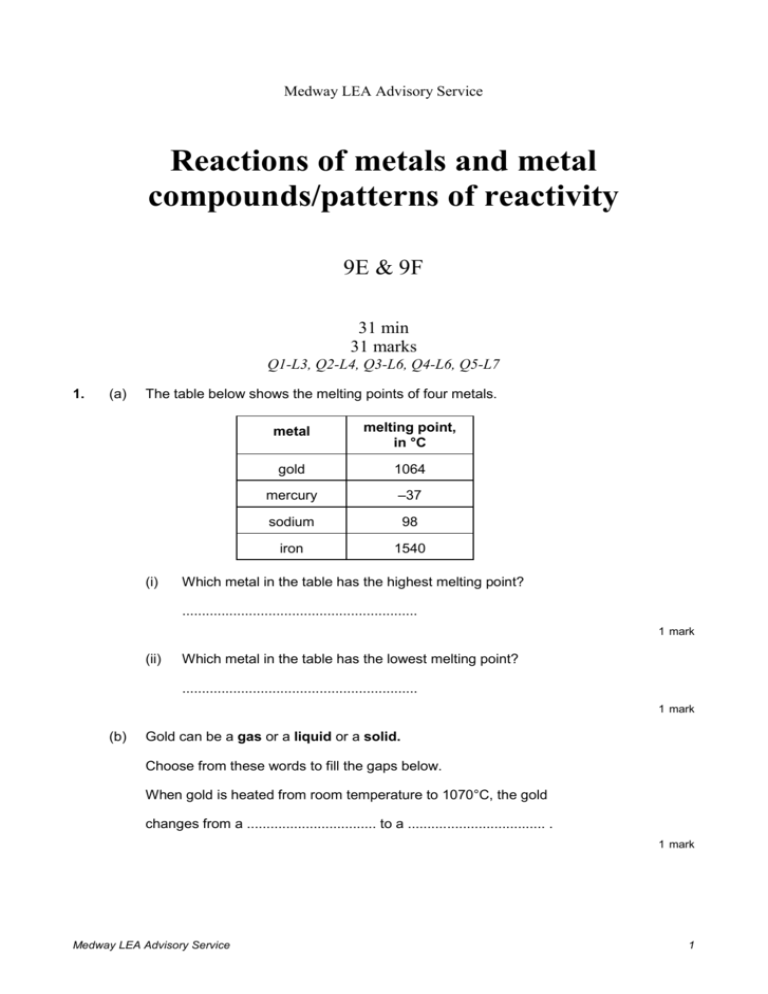
Medway LEA Advisory Service Reactions of metals and metal compounds/patterns of reactivity 9E & 9F 31 min 31 marks Q1-L3, Q2-L4, Q3-L6, Q4-L6, Q5-L7 1. (a) The table below shows the melting points of four metals. (i) metal melting point, in °C gold 1064 mercury –37 sodium 98 iron 1540 Which metal in the table has the highest melting point? ............................................................ 1 mark (ii) Which metal in the table has the lowest melting point? ............................................................ 1 mark (b) Gold can be a gas or a liquid or a solid. Choose from these words to fill the gaps below. When gold is heated from room temperature to 1070°C, the gold changes from a ................................. to a ................................... . 1 mark Medway LEA Advisory Service 1 (c) 5 g of gold is melted and all of it is poured into a mould to make a pendant as shown below. What is the mass of the gold pendant? ........................... g 1 mark (d) The table below shows how the four metals react with oxygen when heated in air. (i) metal reaction when heated in air gold no change mercury slowly forms a red powder sodium bursts into flames straight away iron very slowly turns black Which is the most reactive metal in the table? ............................................................ 1 mark (ii) Which is the least reactive metal in the table? ............................................................ 1 mark Maximum 6 marks 2. (a) The table below shows the percentage of carbon in four different materials. Medway LEA Advisory Service 2 name of material percentage of carbon in the material cast iron 4.5 high carbon steel 0.8 mild steel 0.3 wrought iron 0.1 Which material has the highest percentage of carbon? ................................................ 1 mark (b) The graph below shows how the percentage of carbon affects the strength of the materials. strength of material 0 1 2 3 4 5 percentage of carbon (i) Use the graph to find the percentage of carbon in the material with the greatest strength. ...................... 1 mark (ii) Use your answer to part (i) to name the strongest material in the table. ................................................. 1 mark Medway LEA Advisory Service 3 (c) Steel rods can be put into concrete beams before the concrete sets. concrete beam steel rods (i) What could these concrete beams be used for? ............................................................................................................. ............................................................................................................. 1 mark (ii) Steel contains iron. Give the name of one other substance which must be present for the iron to go rusty. ................................................. 1 mark Maximum 5 marks Medway LEA Advisory Service 4 3. Jessica was investigating the rusting of iron. She set up five experiments as shown below, and left the test-tubes for three days. A B iron nail in distilled water D C iron nail in tap water which has been boiled to remove dissolved gases iron nail and a chemical to absorb water vapour E iron nail in sea water iron nail in vinegar Jessica wrote the following results in her book. Test–tube Medway LEA Advisory Service observation A nail slightly rusty B nail still shiny C nail still shiny D nail very rusty E nail slightly rusty, bubbles of gas seen 5 (a) Explain why the nails had not rusted in test-tubes B and C. in test-tube B ………………………………………………………………………. ……………………………………………………………………………………….. in test-tube C ………………………………………………………………………. ……………………………………………………………………………………….. 2 marks (b) In test-tube E the iron nail reacted with the vinegar. (i) Is vinegar acidic, alkaline or neutral? …………………………………. 1 mark (ii) When the iron reacted with the vinegar, bubbles of gas were formed. What gas was formed? …………………………………. 1 mark (c) Before putting the iron nail in test-tube D, Jessica weighed the nail. After three days she dried and weighed the nail and the rust which had formed. (i) How did the total mass of the nail and rust compare to the mass of the nail at the beginning? ………………………………………………………………………………… 1 mark (ii) Give the reason for your answer. ………………………………………………………………………………… ………………………………………………………………………………… 1 mark (d) Jessica concluded that the presence of salt in the water made the nail rust more quickly. Explain why she drew that conclusion from her experiments. ……………………………………………………………………………………….. ……………………………………………………………………………………….. ……………………………………………………………………………………….. 1 mark Maximum 7 marks Medway LEA Advisory Service 6 4. The diagram shows an outline of part of the Periodic Table of Elements. H region 3 region 1 region 2 (a) What is the name of the element with the symbol H? …………………………………. 1 mark (b) In which regions of the Periodic Table are the following types of element found? (i) non-metals (such as oxygen and chlorine); region ………… 1 mark (ii) very reactive metals (such as sodium and potassium); region ………… 1 mark (iii) less reactive metals (such as copper and zinc). Region ………… 1 mark (c) Why is copper sulphate not found in the Periodic Table? ………………………………………………………………………………………. ………………………………………………………………………………………. 1 mark (d) An iron nail is placed into some blue copper sulphate solution. A reaction takes place between the iron and the copper sulphate. (i) Complete the word equation for the reaction. iron + copper sulphate ……………………… +………………………… 1 mark Medway LEA Advisory Service 7 (ii) Describe one change you would see on the surface of the nail. ………………………………………………….……………………………. ……….………………………………………………………………………. 1 mark Maximum 7 marks 5. Railway lines can be joined together by pouring molten iron into the gap between them. (a) The molten iron is produced by the reaction between powdered aluminium and iron oxide. Complete the word equation for the reaction. aluminium + iron oxide iron + ………………………………. 1 mark (b) Iron can be produced from a mixture of aluminium and iron oxide but not from a mixture of copper and iron oxide. Write the names of the three metals, in the order of their reactivity. most reactive …………………………. …………………………. …………………………. 1 mark (c) The list shows the names and symbols of five metals in order of their reactivity. (i) name symbol sodium Na calcium Ca magnesium Mg zinc Zn silver Ag What, if anything, would be the result of heating zinc powder with calcium oxide? ……………………………………….………………………………………. 1 mark (ii) Write down the name of a metal in the list that will not react with a solution of magnesium sulphate. …………………………………. 1 mark (d) The powdered metal with the symbol Zn burns in air. Medway LEA Advisory Service 8 Write the word equation for the reaction. ………………………………………………………………………………………. 2 marks Maximum 6 marks Medway LEA Advisory Service 9

